The musk turtle is among the most popular turtles kept as pets. This interesting turtle is endemic to North America and is considered a terrapin. While the common name usually refers to the common musk turtle, it can also be refer to all musk turtle species such as the razorback musk turtle, and the loggerhead musk turtle.
Quick Reference Section
Table of Contents
- Experience level: Beginner
- Family: Kinosternidae
- Scientific name: Sternotherus spp.
- Average adult size: 3 to 5 inches
- Lifespan: 30 to 50 years
- Clutch size: 14 eggs
- Egg incubation period: 60 to 85 days
- Food: Aquatic Turtle Food
- Tank size: 25 gallons
- Average temperature: 85°H/75°L
- UVB lighting: needed
- Average price range: $20 to $50
- Conservation status: Least Concern on IUCN Red List
Musk turtles and mud turtles are similar in appearance and both belong to the family kinosternidae. While there are several types of musk turtles, the common musk turtle (Sternotherus odoratus) also known as stinkpot turtle is the most popular.
Other musk turtles include the razor-backed musk turtle (Sternotherus carinatus), loggerhead musk turtle (Sternotherus minor), and the flattened musk turtle (Sternotherus depressus).
These turtles are native to North America, in particular, eastern United States.
Musk Turtle Species
1. Razorback Musk Turtle
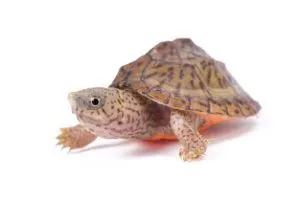
Quick Facts
- Experience Level: Intermediate
- Family: Kinosternidae
- Scientific Name: Sternotherus Carinatus
- Common Names: Razor-backed musk turtle
- Average Adult Size: 5.9in (15cm)
- Lifespan: 20+ years
- Average Price Range: $30.00 – $60.00
The razorback is one of the largest of the musk turtles and has a lifespan of roughly 20 years. The longest recorded living turtle was 29 years up to this date.
Learn More about the Razorback Musk Turtle
2. Flattened Musk Turtle
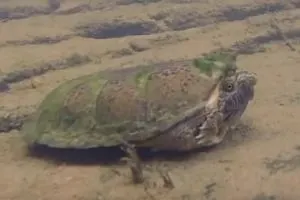
Quick Facts
- Experience Level: Intermediate
- Family: Kinosternidae
- Scientific Name: Sternotherus depressus
- Common Names: Flattened Musk Turtle
- Average Adult Size: 3.0–3.9 in (7.5–10cm)
- Lifespan: 50+ years
- Average Price Range: n/a
As you may expect from the name the Flattened Musk turtle has a shell that is more flat rather than high domed. They are typically brown in color with the head having a olive color with speckles on it.
Learn More about the Flattened Musk Turtle
3. Common Musk Turtle
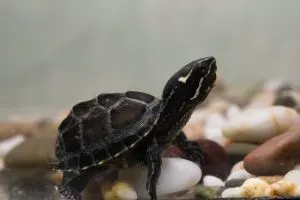
4. Quick Facts
- Experience Level: Intermediate
- Family: Kinosternidae
- Scientific Name: Sternotherus odoratus
- Common Names: Stinkpot Turtle, Eastern Musk Turtle
- Average Adult Size: 2 – 5.5in (5 – 14cm)
- Lifespan: 50+ years
- Average Price Range: $25.00 – $60.00
The common musk turtle is relatively small in size for a turtle and makes for a fairly good pet as water turtles go.
Learn More about the Common Musk Turtle
5. Loggerhead Musk Turtle
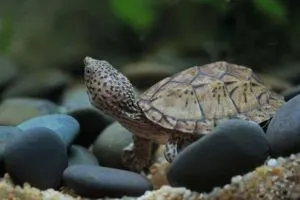
Quick Facts
- Experience Level: Intermediate
- Family: Kinosternidae
- Scientific Name: Sternotherus minor
- Common Names: Loggerhead Musk Turtle
- Average Adult Size: 3–5 in (8-13cm)
- Lifespan: 20+ years
- Average Price Range: $200.00 – $350.00
There are two subspecies of the loggerhead musk which are the Stripe Neck Musk Turtle and the Nominate Loggerhead Musk Turtle.
Learn More about the Loggerhead Musk Turtle
6. Intermediate Musk Turtle

Quick Facts
- Experience Level: n/a
- Family: Kinosternidae
- Scientific Name: Sternotherus intermedius
- Common Names: Aliflora musk turtle
- Average Adult Size: 3 – 4in (7.5 – 10cm)
- Lifespan: ?
- Average Price Range: n/a
Previously the Aliflora Musk Turtle or Intermediate Musk turtle as you may know it was thought to be a hybrid of the loggerhead musk turtle and stripe-necked musk turtle.
This theory has been dispelled. Turtle is the Choctawhatchee and Escambia River basins are in their own ecosystem and thus are on their own path of evolution.
The theory of evolution for this species has to do with the migration of the musk turtles and the changes in climate. All of these combined events have created the evolution of the intermediate musk turtle.
Learn more about it here.
7. Mexican Giant Musk Turtle
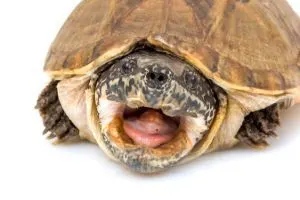
Quick Facts
- Experience Level: Beginner
- Family: Kinosternidae
- Scientific Name: Staurotypus salvinii
- Common Names: Giant Musk Turtle, Pacific giant musk turtle, and the Chiapas Giant Musk Turtle
- Average Adult Size: 15in (38cm)
- Lifespan: 30+ years
- Average Price Range: $129.00 – $179.00
The Giant Musk Turtle is another one of the larger musk turtles and spends the majority of its time in the water.
8. Narrow-bridged Musk Turtle

Quick Facts
- Experience Level: Advanced
- Family: Kinosternidae
- Scientific Name: Staurotypus triporcatus
- Common Names: Mexican musk turtle
- Average Adult Size: 14in (36cm)
- Lifespan: 16 years
- Average Price Range: $500.00 – $1200.00
The Mexican musk turtle can be identified by its color which is usually either brown, black, or green in color, with a yellow underside.
The carapace also has three distinct ridges which run the length of their shell.
Musk Turtle Habitat
Musk turtles are aquatic turtles. We can find them in clear water lakes, rivers, ponds, shallow streams. We can find them in many types of a permanent body of water.
They prefer the shallow parts of the water body they inhabit. This genus can be found basking on tree trunks and branches of trees overhanging the water. As North American turtles, they thrive in temperate climates.
Musk Facts And Care Sheet
Enclosure
As an aquatic reptile, the musk turtle requires an aquatic habitat. A suitable enclosure is an aquarium or a small pond such as a koi pond. As already mentioned, they prefer shallow waters and don’t need a tall aquarium. How deep should the water be?
The water level should be deep enough for the turtle to paddle in, but shallow enough for the turtle to touch the bottom but still be able to stretch to the surface. I recommend a tank with a capacity between 20 to 40 gallons. A 20-gallon tank such as the Marina Led Aquarium Kit (20 Gallons) is adequate for a single adult.
For two adults, I recommend a 40-gallon tank such as the Aqueon Tank Breeder. Ensure that the water used in the aquarium is dechlorinated as this is best. There are several ways to dechlorinate water. I recommend using a dechlorinator such as the Tetra Aquasafe Plus Dechlorinator.
Freshwater turtles need a platform to bask on. It allows them to regulate their body temperature and dry their shells. Using a plastic basking platform is the most popular choice.
One of the most popular turtle basking platforms is the Penn Plax Turtle Tank Topper – Above-tank Basking Platform. For a more natural-looking basking platform, you can use natural habitat rocks.
As with any aquarium, you need a water filter and pump. A submersible canister water filter such as the Fluval U2 Filter should be good enough for a single adult turtle in a 20-gallon aquarium.
For a pair of adults in a 40-gallon aquarium, I recommend the Fluval U3. This should be good enough. Besides a filter, you need to change the water regularly. Change about a third of the water every week
With housing arrangements, you can keep a male and a female in the same enclosure but not two males as these turtles can be territorial. Even with a male and female, the male may harass the female. In this case, separate them.
Substrate
As with other turtles, it is unnecessary to have a substrate. The turtles don’t need it. However, many keepers add substrate to give the aquarium a natural appeal. A good substrate is one that doesn’t dissolve in the water.
Temperature
Maintaining a suitable temperature is necessary for the survival and comfort of the turtle. These turtles require temperatures between 70 to 90 F. It is usually unnecessary to heat the aquarium since the temperature in most rooms is in the right range.
Ideally, the water temperature needs to be around 75 F. The basking temperature needs to be around 90 F. Use a basking lamp such as the Zoo Med Aquatic Turtle UVB & Heat Lighting Kit to achieve the needed temperature. You can also use a ceramic heat lamp. Use a thermostat to help you maintain the right temperature range.
Lighting
This turtle needs UVB light to synthesize the required vitamin D3. You can use a mercury vapor lamp to provide both the UVB light and the heat needed. A popular choice is the Zoo Med Aquatic Turtle UVB & Heat Lighting Kit, which was mentioned in the previous section. You can also use a fluorescent light to provide the needed UVB rays.
Another light source to consider is the sun. Since direct sunlight can easily overheat the aquarium, you need to provide access to indirect sunlight. You can place the aquarium in a well-lit room as far as it’s out of the way of direct sunlight.
Accessories
Accessories can spice up the enclosure and adds to the aesthetics. These accessories can also serve a practical function. Some accessories to consider include driftwood and artificial plants.
Feeding The Musk Turtle
Musk turtles are primarily carnivorous and may not accept plant foods. In the wild musk turtles feed on aquatic insects, amphibians such as frogs, crustaceans, worms, mollusks, and even carrion.
Juveniles eat small prey such as beetles, millipedes, worms and small snails. While adults eat bigger prey and would even feed on clams. Occasionally, musk turtles will consume plant food such as duckweed and waterweeds (Elodea).
An excellent food choice is commercial turtle diets. Now only are these convenient, they provide the turtle with all the needed nutrients. For hatchlings and juveniles, the Zoo Med Natural Aquatic Turtle Food (Hatchling Formula) is perfect. However, you can always feed juveniles with the same diet you would feed an adult with. Tetra Reptomin Floating Food Sticks for aquatic turtles works for both adults, and juveniles.
They also accept other live prey such as mealworms, bloodworms, crickets, trout chow, and shrimp. Variety is good as it enjoys the turtle doesn’t become fixated on just one food type.
You can find these foods in most pet shops. You can also have insect farms. These are useful when you need to feed several reptiles and amphibians. Sequoia Aquatic Turtle Medley Food contains freeze-dried mealworms and shrimp are readily accepted.
Simulate feeding by providing live prey. However, if the turtle accepts commercial turtle foods, these are highly recommended as they contain all the needed nutrients. Nutrient deficiency can be a huge problem with captive-bred reptiles.
Feed hatchling every day, and pre-adults every other day. Feed adults thrice or even twice a week. Feed them as much as they can eat within 5 minutes. Feeding your pet turtles is a great way to bond with them. It is an enjoyable activity for most turtle keepers.
Feeding them wild prey and food is not the best as they may contain harmful insecticides and pesticides.
Musk Turtle’s Temperament & Handling
Turtles aren’t the most interactive pets. Because common musk turtles may attempt to bite when handled. You need to be careful when handling them.
Ensure your fingers are at the rear of their shell to avoid being bitten. Another name for the common musk turtle is stinkpots because of the foul smell this reptile emits when threatened. After handling the musk turtle, wash your hands properly since they may carry salmonella.
Musk Turtle’s Lifespan
The lifespan of musk turtles is long. Their lifespan in the wild is difficult to determine. However, in captivity, common musk turtles have an average lifespan of 55 years. These are the most popular of the musk turtles. Loggerhead musk turtles can live to be 23 years. Razorback musk turtles can live to be 50 years. Flattened musk turtles can live to be over 20 years.
While there are several musk turtle species, the ones that make ideal pets include the common musk turtles and the razorback musk turtles. They are also the easiest to breed. As they live long, they require a lifelong commitment.
Common Health Concerns
Musk turtles are strong turtles that are disease-free. Here are some health concerns to be ary of.
Fungal infection
Basking is essential as it allows the turtle to dry off. This helps keep fungal infections at bay. Ensure the basking platform is large enough for the turtle to dry off with no part of it in the water. Also, the heat lamp needs to produce enough heat.
Cuts and bruises
If you notice cuts and bruises, look for sharp edges that may be the culprit. If several turtles are housed together, look for an aggressor. If there is an aggressor, house it in a separate container. You can treat the cuts and bruises with topical treatments such as Betadine solution.
Vitamin deficiency
Lack of vitamin a can lead to respiratory issues and swollen eyes. Similarly, vitamin d deficiency can lead to metabolic bone disease. When not treated, vitamin deficiency can lead to severe complications. Ensure you feed the turtle a balanced diet. Supplement their diet with commercial turtle diets that contain all the needed nutrients.
Signs to look out for include loss of appetite, unresponsiveness to stimuli, presence of cuts, bruises, blisters, and sores, foul-smelling mouth with thick mucus, and swollen eyes that aren’t clean and clear.
Pricing and Availability
When adopting a musk turtle, do so from a reputable breeder or a rescue organization. Ensure the turtle is not under 4 inches in carapace length. You can find musk turtles in many pet shops and even online. They cost between $20 to $70.
Here are some reputable online stores that offer musk turtles – myturtlestore, underground reptiles, turtle source, and snakes at sunset.
Conservation/Threats
On the IUCN Red List, all the species of the genus Sternotherus are listed as of least concern except the flattened musk turtle which is critically endangered.
The main threat to the flattened musk turtle is strip mining which heavily pollutes the habitats of the species. Conservation actions proposed include local efforts to improve the water quality of the species natural habitats, and the enforcement of mining laws and regulations.
Musk Turtle Care Video
Conclusion
The common musk turtle is one of the most loved turtle species. This is because they are easy to care for and are small. Endemic to the east coast of North America, they are easy to find in most pet shops that have turtles available.
Although they are tiny reptiles, musk turtles are long-lived and can easily live to be 50 years. They can also be aggressive and may bite when threatened. If you have any questions, or extra information about the musk turtle, kindly leave a comment.

Dan
Friday 10th of January 2020
I was wondering if you can identify the turtle I'm showing in this dropbox link. I would like to make sure I am giving him optimal care.. but am having trouble indentifing him.
Thank you!
https://www.dropbox.com/sh/e367lsjlqfseiqk/AAB_rFF5kj4tQSMr-xASFLrta?dl=0